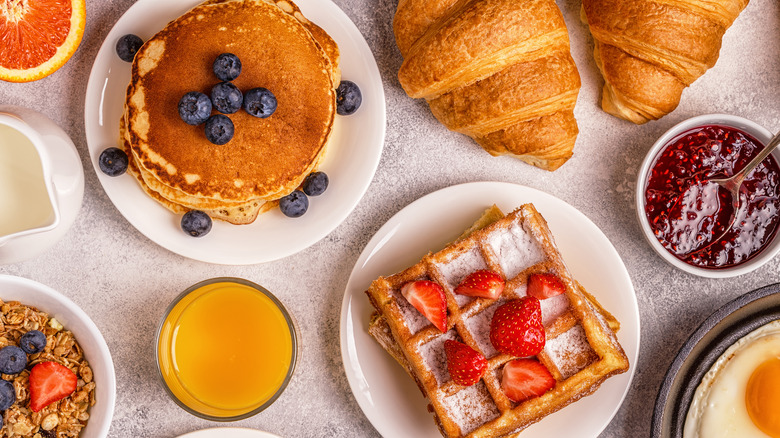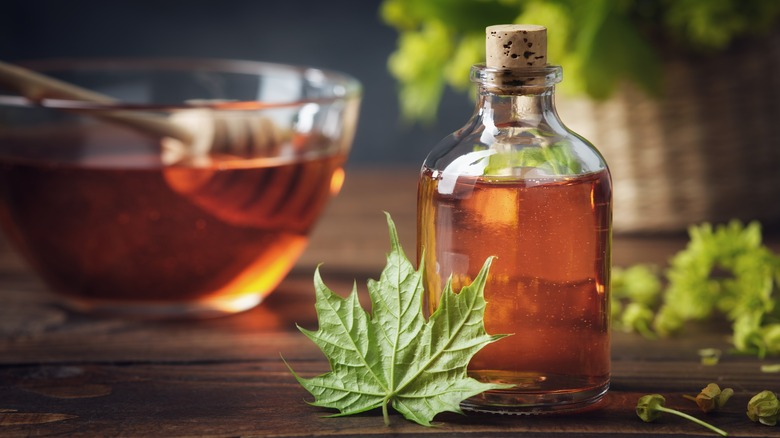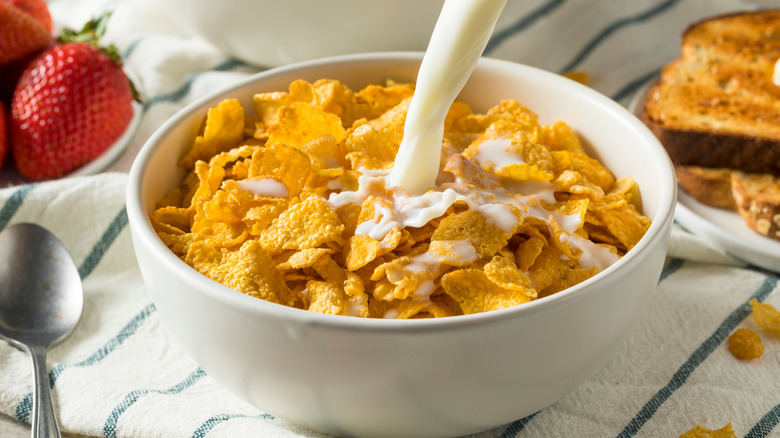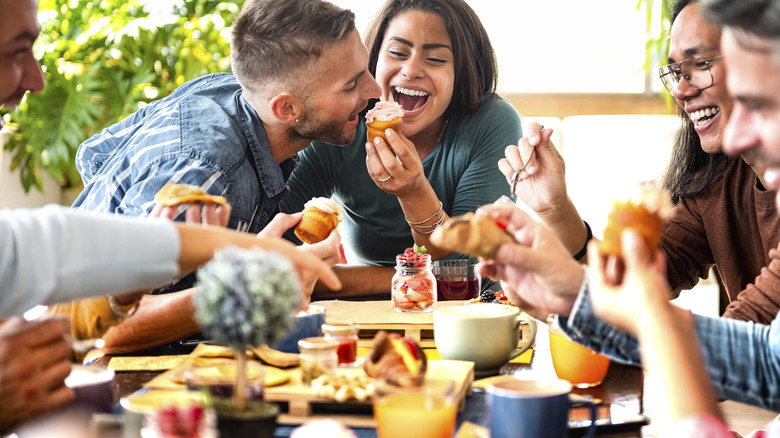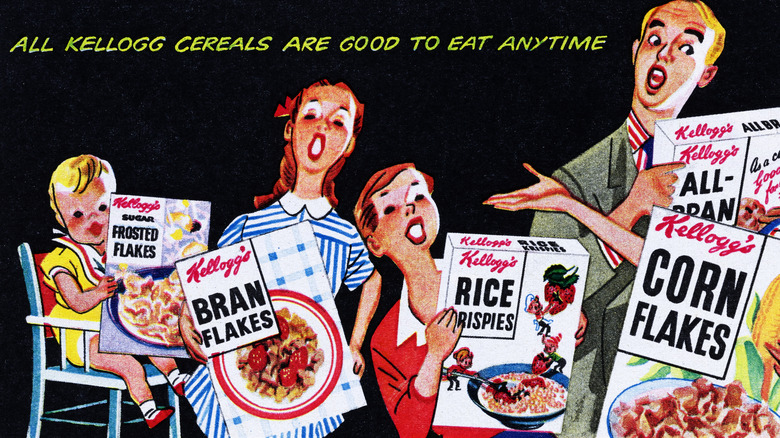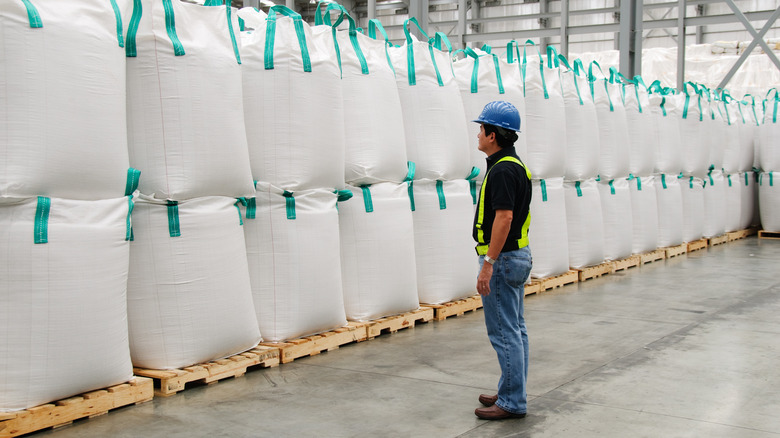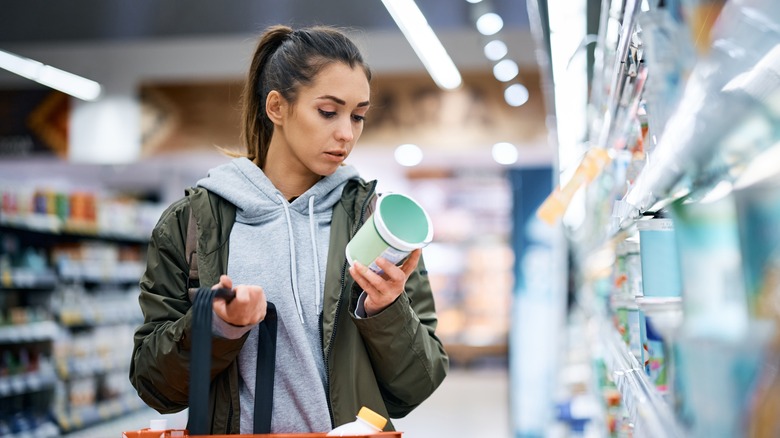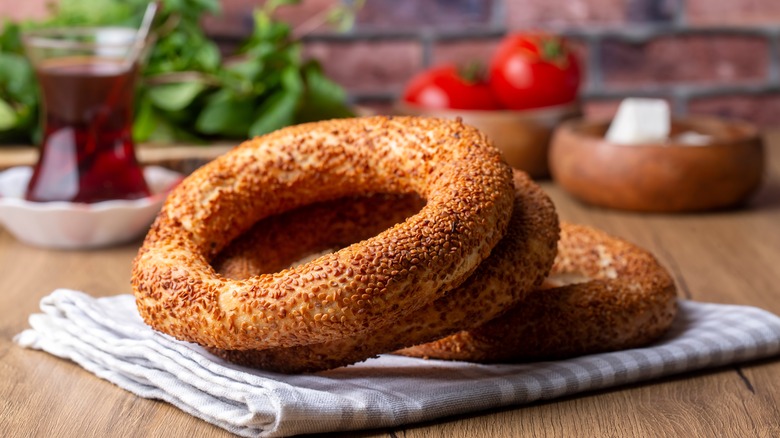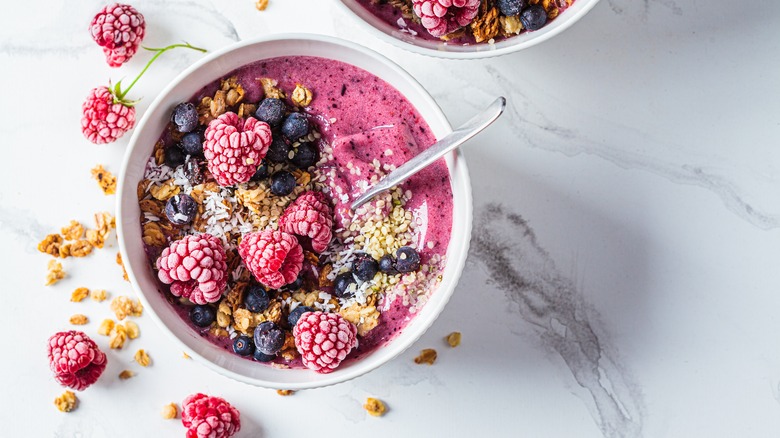We Finally Know Why Americans Like To Eat Sweets For Breakfast
When you think of American breakfasts, the first things that come to mind may be bacon and eggs — but there's a whole other side of the plate that's much more iconic than you might think. From fluffy pancakes doused in maple syrup, sugary cereals drowning in milk, pastries smothered in chocolate and glaze, coffees sweetened until the coffee taste is no more, and that glass of fruit juice ripened with sweeteners you don't know about — sweet breakfasts have come to reign supreme in America.
But why is that? While the rest of the world wakes up to savory bowls full of bold flavors or hearty slices of meat, why do we have a morning urge to consume sugars? We might mock the idea of dessert for breakfast, but is America unknowingly indulging in it daily?
While waking up to the smell of cinnamon rolls just seems to be the norm, there's a fascinating history as to why sweets have found a permanent home in our breakfast platter. It's a blend of America's evolving culture and economy, some genius (or sneaky?) marketing, and unfortunately, some misinformation as well. In this list, we compiled the delightful history and a bit of the science behind why Americans prefer to start their day on a sweet note. And who knows, by the end, you might look at your morning waffles in an entirely new light.
Historically, American breakfasts have always been sweet
Picture this: Before the sun has fully risen over Colonial America, families gather around their hearth, coaxing a pot of creamy cornmeal or oat — the precursor to our beloved oatmeal. Depending on where you were and what was within arm's reach, this warming breakfast could be sweetened by a dollop of butter, a drizzle of molasses, or perhaps a generous splash of maple syrup — which was produced after early settlers of the U.S. Northeast gleaned the secret of the sugar maples from their Native American neighbors. More than porridge, families also feasted on corn breads — which, back then, were called hoecakes and johnny cakes. They were the breakfast staples that graced households for generations, all the way to this day and age where they share the table with more modern breakfast bakes.
Fast forward to when the colonies unified into a single nation, the new era brought with it not only a sense of identity, but also the blessings of affordable sugar. No longer a luxury, sugar now sat on pantry shelves alongside honey, molasses, and maple syrup, resulting in an outpouring of breakfast breads. One could wake up to the aroma of Sally Lunn — a sweet, cakelike bread — or perhaps be greeted by the tempting spirals of the first rendition of cinnamon rolls and sticky buns. Thus, history shows us that America's sweet tooth didn't just appear overnight, but was formed through generations, leaving us with the sweet legacy we savor today.
Americans need quick bites and sugar spikes in the morning
In a country that prides itself on its "go-getter" mentality, time is a luxury. So, breakfast better be quick, filling, and well ... sweet. Why? There's an underlying belief that sugar delivers that much-needed energy boost — breakfast is the most important meal, right? Not to mention, that prepackaged treat is just so convenient when you're running late for school, so what if it's a bit sweet? But is that morning muffin really giving us the kick we think it does?
Sugars, being the most straightforward form of carbs, offer a tempting promise — a rapid energy lift. This is because our body processes them at breakneck speed, giving us an exhilarating, if not fleeting, energy jolt. However, this sugar high merely comes and goes. You'll feel a rapid plummet in your blood glucose levels, leaving you wanting elevenses and your concentration broken in mere hours.
Sure, a bite of a sweet pastry is nothing to fret about. But with off-the-charts calorie counts and a lack of fiber, our bodies process this sugary confection faster than our organs are wired to handle. Evolution never prepared our digestive systems for such a sugar bombardment. A significant chunk of this sugary overload gets promptly escorted into our visceral fat stores. So, while America's love for quick, sugary breakfast bites does stem from a genuine need for a quick pick-me-up, understanding sugar's role in health can help us navigate our mornings with more informed choices.
The bittersweet rise of breakfast cereals
Imagine America without breakfast cereal. It seems inconceivable. In fact, an impressive 283 million Americans poured milk over boxed cereals in 2020! America's relationship with breakfast cereal has been, well, a bit of a roller coaster. Did you know cereal was invented with health-focused beginnings? Before the age of vibrant cereal boxes, Dr. John Harvey Kellogg was focused on improving his patients' digestive health, leading him to craft what we'd now recognize as granola, using a combination of flour, oats, and cornmeal. But in 1894, when a batch of Kellog's wheat dough was forgotten, it became stale and was flaked into what we now recognize as cereal. Then, in 1906, his younger brother introduced the one and only Corn Flakes — which he added sugar to in hopes it would appeal to a wider audience, transforming morning meals across the nation.
As women began making their way into the workforce to support their families, there was a growing need for a quick, child-friendly breakfast solution. Cereals were a godsend: safe (no need for kids to work a stove) and easy. Cereal was often the first meal many kids learned to prepare themselves — and who could forget those mornings when mastering the milk-to-cereal ratio felt like a rite of passage? Whether as a health food (for a while, at least) or a sugary treat, cereals have indeed weathered the test of time to sweeten our breakfasts to this day.
Morning indulgences are like daily celebrations
Have you ever woken up in the morning dreading the day ahead of you, then remember that you're having a gooey cinnamon roll or a crispy waffle for breakfast? Sweets, undeniably, are the epitome of comfort food. They embrace us in moments of weariness, wrapping us in memories of happier times. Most of our love for these indulgent bites comes from a combination of chemicals and nostalgia. Foods rich in sugar, fat, and salt have a way of playing with our brain's reward system like a symphony, urging our brain to release those euphoria-inducing chemicals, notably dopamine. This sensation isn't merely sensory; it's deeply rooted in the biology of our brain. After indulging, the rush of dopamine momentarily melts away stress and tension.
For many, these breakfast desires are also moments of connection. Perhaps you recall the soft warmth of your dad's fresh-baked bread on a snow day. Or maybe it's the chocolate chip cookie your grandmother used to make. The craving for these comfort foods can strike morning or night, but breakfast offers a unique opportunity to start the day enveloped in the comforting memories and tastes of yesteryears.
Whether our cravings are triggered physiologically or psychologically, celebrating mornings doesn't necessitate a sugar overload. How about having a bowl of fresh fruit? Or a bite of that richly bitter dark chocolate paired with almonds? While a new dawn can be a celebration, there's more than one way to enjoy the feast.
Powerful advertising can shape food preferences
What if we told you that your choice of cereal wasn't entirely yours? Your love for sweet breakfasts was, in part, artfully designed by advertising experts over the years. In fact, over $13.5 billion was splurged on media advertising by over 20,300 food and beverage companies in 2016 alone. Most people don't even know this, but advertising was practically actually invented to sell cereal. That's right, the staple of American breakfasts is the father of billboards and print ads. Moreover, these advertisements were primarily targeted at children — with an average child witnessing a staggering 4,000 advertisements in a year. Imagine the subconscious influence!
Take for example the first ever cereal mascot, Sunny Jim. Not only was this an unprecedented marketing success in the 1900s, but it paved the way for the likes of Tony the Tiger and Toucan Sam to grace our breakfast tables and televisions to this day. However, these cereals were — and mostly still are — brimming with sugars. Mounting concerns led to regulations in the late 20th century, with the Children's Television Act of 1990 curbing ads in children's programming. By 2006, major cereal brands committed to promoting healthier options through their ads.
It's evident that commercials profoundly influence children, and in turn, shopping lists. Thus, the need to regulate and perhaps rethink our perceptions of food advertising and our approach to grocery shopping becomes paramount — especially because advertising can be a bit dubious about their true nutritional values.
Blame the coffee chain craze
Everywhere you look, from corner bodegas to fancy urban high rises, you're bound to spot someone clutching a branded coffee cup in the morning. Truly, cafés are becoming a cultural phenomenon. A survey revealed that a good 49% of respondents drank 3 to 5 cups daily, with nearly a third of these coffee lovers making purchases from a coffee shop multiple times a week (via Drive Research). This makes sense, given that it's such a convenient place to grab a cup and a sweet pastry on the side, too — not to mention they're trendy.
However, you might not realize how jaw-dropping the sugar content is in your favored drink. For example, Dunkin Donuts recently revealed the Pumpkin Swirl Frozen Coffee — it sounds delicious. But know that it has a whopping 185 grams of sugar, equivalent to gobbling down 14 glazed donuts in one go! With such staggering figures, that modest medium-sized beverage is actually packing more sugar than the FDA recommends in an entire day. Even just an average iced coffee might be the equivalent of guzzling down 5 cans of Coke — it's a caffeine hit that's more sugar-rush than wake-me-up.
With whipped creams, flavored syrups, and a side of pastry, coffees are becoming more than just about the beans at these coffee chains. Next time you find yourself in line waiting for that frothy, icy, sugary beverage, maybe think twice before you ask for that extra pump of caramel.
Americans simply love the taste of sweetness
Maybe the answer is as simple as Americans like how sweets taste. Everyone does, right? Well, while human bodies gravitate towards sugar, Americans take it to a whole new level. With an astonishing 42% of an average American's daily caloric intake coming from sugar — a staggering leap from the recommended 10% — it's evident that the American palate has an insatiable appetite for sweets, with an average intake of 126 grams a day. It's a love affair that's so intense, that some experts have likened this collective sweet tooth to nicotine dependence, highlighting just how challenging it can be to resist.
As we savor that frosted doughnut, our brain releases a surge of feel-good chemicals, like serotonin, which make us crave that sugar high. Sugar taps into the same biochemical systems in our brain that reward us for other pleasurable activities. In layman's terms? The same systems that make us feel joy from life's great accomplishments can be triggered by a mere sprinkle of sugar. Food companies, in their bid to win our hearts (and wallets), have perfected the art of identifying which flavors will make our taste buds crave more immediately. Spoiler alert — sugar often tops that list. While the world may scratch their heads at syrupy American breakfast choices, it's worth noting that, while indulgence sure is a factor, biology, psychology, culture, and the environment also play a crucial, perhaps dangerous, role in starting this love affair with sweets.
Sweet breakfasts were driven by industrialization
The rise of America's sweet breakfast table is also deeply intertwined with the ebb and flow of economic forces — particularly in the aftermath of the Industrial Revolution. The Industrial Age wasn't just about steam engines and railways; it marked a significant turning point in our dietary choices. In 1856, Williamsburg, Brooklyn celebrated the birth of the largest and most advanced sugar refinery the world had seen. This massive advancement in sugar tech meant one crucial thing: American sugar was now easier and cheaper to produce, flooding markets with a commodity that was once a luxury.
In the late 1970s, high fructose corn syrup (HFCS) came at a pivotal moment when sugar prices were soaring, partly because of restrictive trade practices, while corn prices plummeted. Some argue it was its even sweeter taste compared to regular sugar, potentially prompting people to consume more beverages sweetened with it. Sensing an opportunity to cut costs, in 1980, Coca-Cola championed the switch to HFCS. By the mid-80s, most of its competitors had hopped on the sweet bandwagon, too.
The history of sweet American breakfasts is a product of several intertwined threads — economic, industrial, and agricultural. As manufacturers found cost-effective ways to sweeten our foods, our palates adapted, and the cycle continued, cementing sugary breakfasts as an American mainstay. The Industrial Revolution might've powered machinery, but it also fueled our collective craving for sweetness.
Sugar is a silent and addictive additive
How often have we grabbed a breakfast snack on the go, not giving much thought to what's inside? After all, it's just a quick bite. However, many of us remain blissfully unaware of how much sugar we're actually consuming, let alone its potential addictiveness. Research indicates the average American ingests about 15 teaspoons of added sugar daily. But most of this sugar isn't coming from the spoonfuls we knowingly add to our coffees. Instead, it's covertly nestled in our packaged foods. There's a list of names you might gloss over on a nutrition label: from barley malt and cane juice crystals to more exotic-sounding terms like maltodextrin, muscovado, and panela.
A treat like a New York cheesecake pancake also contains nearly 21 teaspoons of sugar. Given that recommended daily sugar limits hover around 12 teaspoons, a single indulgent breakfast can almost double the quota. Even that innocuous-looking muffin you grabbed on the go? It's quietly harboring roughly 9 teaspoons of sugar.
But why do we still keep going back to it? Well, eating sweet foods ignites our brain's reward system, known as the mesolimbic dopamine system. It's the same chemical thrill that illicit drugs trigger in our system. In fact, studies have highlighted unsettling parallels between sugar and drugs like cocaine (via Wellness Retreat). Thus, our relationship with sugar is a deeply entrenched, systematic cycle we unknowingly reinforce every morning — making it harder to break free the next day.
International traditions changed the American breakfast
America, with its vast expanse and diverse heritage, has a breakfast palate influenced by a medley of global traditions brought by waves of international immigrants across history. For example, in the heart of Philadelphia, a place where Ben Franklin once sang praises of corn cakes and coffee, Swiss and German settlers introduced the alluring Philadelphia sticky or cinnamon bun. In Pennsylvania, Georgia, and North Carolina, the Moravians generously introduced the Moravian sugar cake — the ancestor of our favorite coffee cakes which are lightly sweetened and perfect for a morning nibble.
Even the humble bagel, a breakfast staple for many, was brought to America by Jewish immigrants in the late 19th century, eventually becoming a widespread breakfast favorite by the 1970s. And even the donut, that quintessential symbol of American civilization was introduced as "olykoeks" by Dutch settlers in New York.
From sticky buns to sugary cakes, bagels, and donuts, America's breakfast plate has truly been a melting pot of international treats — a testament to the nation's diverse cultural heritage. While some of the reasons why Americans like to eat sweets for breakfast can be a bit dubious, it's a beautiful realization that America's love for sweet breakfasts is not just a taste preference, but a heartwarming tribute to its multicultural roots.
Healthy breakfast foods are sweeter than they seem
When it comes to morning meals, the modern American is inundated with options. With a kaleidoscope of boxes, pouches, and containers screaming promises of health, how does one pick the truly nutritious from the not-so-much? Today, brightly colored labels shout "low fat," "vegan," "gluten-free," and "low carb" from every corner. While these buzzwords imply health benefits and tempt consumers into thinking they're making the best dietary decisions, they can often be misleading smokescreens. The devil is in the details — or in this case, the sugar content.
Take granola and yogurt for instance. These seemingly healthy options have long been breakfast staples for the health-conscious. Yet, the market is flooded with yogurts that may as well be desserts — like Key lime pie and Philly cheesecake versions. The rule of thumb? Opt for plain versions, which are generally free of the hidden sweet traps.
Ah, and then there are smoothies. While a homemade blend might nourish, a store-bought version might leave you feeling drained due to its high sugar content. Often, they're packed with artificial sweeteners, fruit juices, and sweetened dairy products, turning them into vessels of excessive calories and sugar. And don't even get us started on smoothie bowls — those crunchy granolas and coconut flakes come with more sugar than your diet recommends. In the quest to uncover why Americans love sweet breakfasts, the real challenge is discerning those that offer true health benefits from the many sweet illusions laid out before us.
